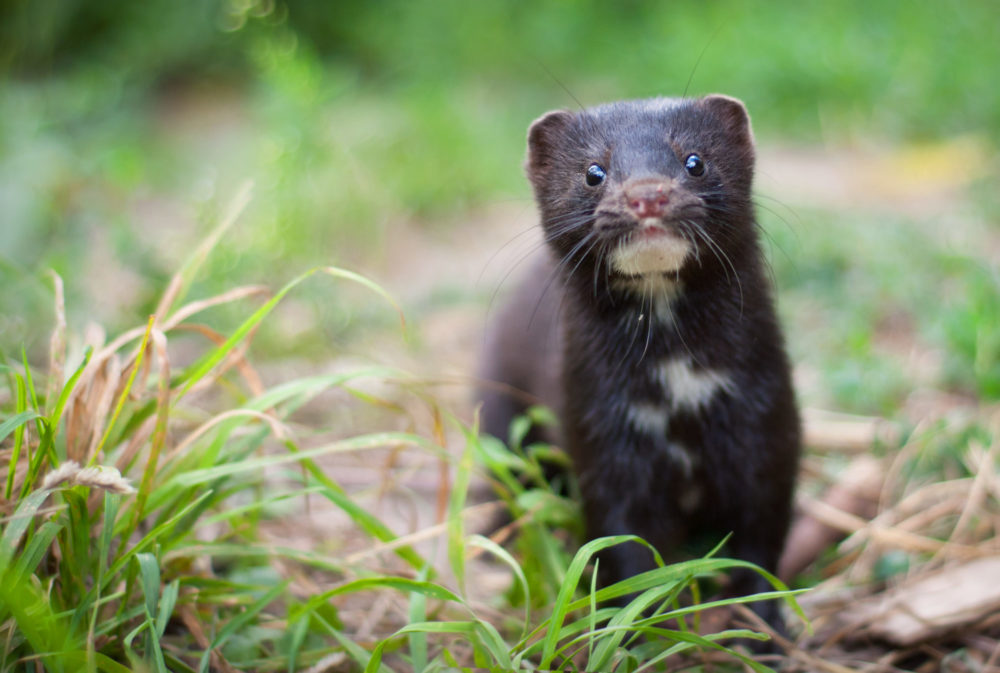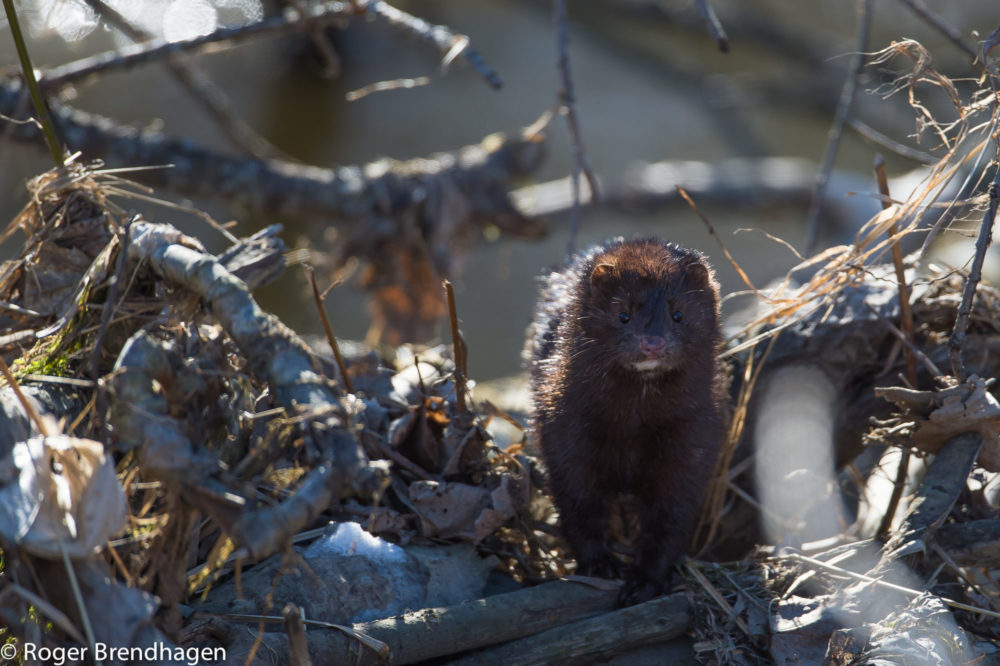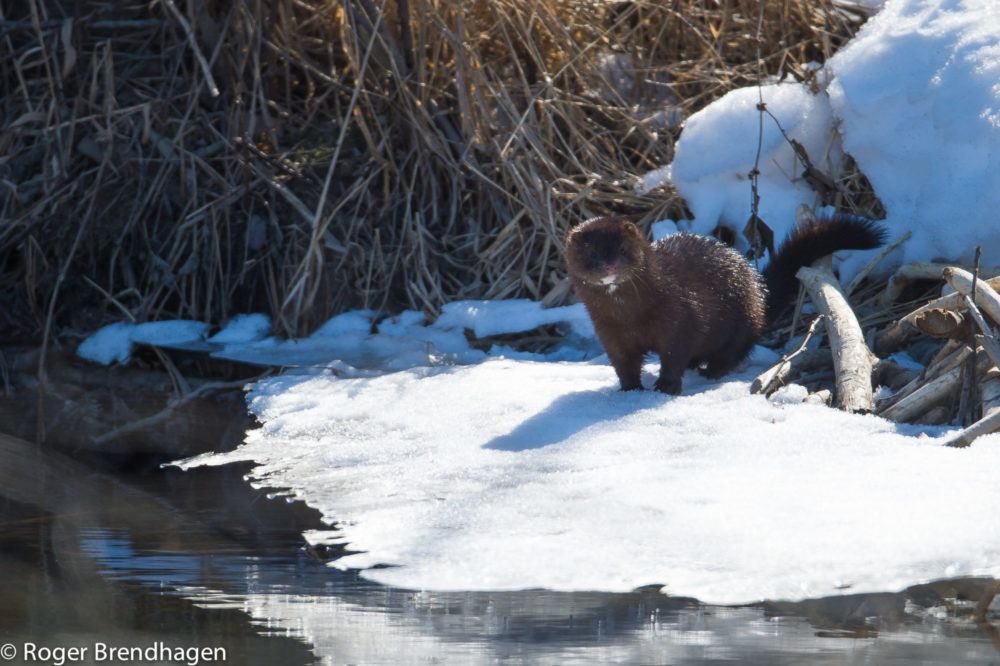Mink
Written by Nicklas Iversen | Last edited 27. August 2021
The mink is a medium-sized mustelid that is not actually native to Norway, but has nevertheless become part of the Norwegian wild.
Mink physiology
The mink has an elongated, relatively muscular body. It has short legs and a thin, fur-covered tail. Its weight and size can vary a bit, with males weighing about 1 kg and females about 500 – 600 grams. Its body is usually somewhere between 30 and 45 centimetres long, while its tail measures between 15 and 23 centimetres.
Its fur is usually black, but , as with other farmed animals, there are many colour variants. That means it is possible to come across both completely white and jet black mink. The more unusual colours are seen on animals that have escaped from farms in the last few generations, as the fur has a tendency to gradually become increasingly brown for each generation that lives in the wild. The fur also tends to be slightly darker in winter than summer, when it is more brownish, although there is no distinct summer and winter coat as with many other mustelids.
The majority of mink have a white patch on their chin, but they can also have white patches on other parts of their body. Such patches are the result of the mink being injured, as its fur then grows back white instead of the usual brown or dark guard hairs.
The mink’s body is well designed for swimming, although the paws do not have very distinct webbing. They can nevertheless dive deep to hunt crustaceans or fish underwater. They are not tied to water, however, and are nearly as good at climbing trees as they are at swimming underwater.
Photo: Ryzhkov Sergey med CC BY-SA 4.0-lisens.

How the mink came to Norway
The mink actually originates in North America, so how come we have it in Norway and the rest of Europe? In fact, it is the result of mink fur being popular for coats, and in the first half of the 20th century it was both common and profitable to keep mink on fur farms.
Norway’s first mink farm was set up in 1927, and by 1930 there was already a wild mink population in Norway. So, all in all, it did not take long for the mink to run off and become established in the wild. It stayed relatively close to the mink farm, of course, but it took just twenty or thirty years for the mink to spread and colonise virtually the whole of Norway.
The mink has by and large lived throughout the country since then and is now even found in Finnmark in the far north. The story is pretty much the same in the rest of Europe, with the mink now being found in virtually all European countries, and every single one of these animals is the descendant of farmed mink.
Today, the mink is on the Norwegian Black List of alien species. It is classified as ‘very high risk’ because it is extremely viable throughout the country, as well as having a tendency to eat the eggs and chicks of red-listed bird species. It is regarded as undesirable in the wild, and measures have therefore been implemented to control it.

What does the mink eat?
The mink is a true predator that eats most of the animals it gets hold of, but fish probably make up the majority of it’s diet. Mink hunt both on land and in the water, of course, so fish, frogs, crayfish, birds, bird eggs, mice and lemmings are all at risk.
Mink are well designed for eating the eggs and chicks of seabirds nesting in colonies, and can do enormous damage in such a colony given the chance. They are not stopped by the eggs being high up, as they are capable climbers and not afraid of heights.
Photo: Stan Lupo med CC BY-NC-NC 2.0-lisens.
Where are mink found?
The mink is native to North America and is found pretty much across the whole continent.
Norway now has mink in virtually the whole country, even in Finnmark in the far north. It lives near water, including streams, rivers, the sea, bogs, marshes, lakes and other wetlands.
Most mink are found in the lowlands, particularly close to the sea. Mink can also make their home quite high up in the mountains, however, as long as there is good access to lakes with fish and other sources of food.
Photo: Tsaiproject med CC BY 2.0-lisens.
How does the mink live?
The mink is a solitary animal, meaning that it lives alone. The only exception is during the breeding season, when the sexes come together to reproduce. If they meet outside the breeding season, or meet a member of the same sex, pushing and bickering will ensue.
Male mink also claim a territory, which they will defend against intruders, but female mink may have smaller territories that overlap with the male’s. Each mink territory contains a den, which will typically be extensive with a lot of passages and several entrances/exits.
The breeding season starts in February and lasts until early April. During this period, the males leave their territory to look for females to mate with and try to find as many as possible while the season lasts.
Although the breeding season is in early spring, the young are not born until late spring because the mink has something called delayed implantation. In the mink’s case, it takes around 30 days from mating until the egg is implanted in the uterus, which means that the young, or kits, are born later in the year, when it is easier for them to survive. This allows the mink to give birth when conditions are best for obtaining enough food for the kits.
When the kits are born in April or May, they are tiny and weigh just 10 grams! Litter size varies enormously from one to eight kits, although litters of between three and seven are most usual. Despite being tiny when born, the kits grow quickly. They are already sexually mature and able to leave their mother at 10 months of age in the autumn.
Photo: Stan Lupo med CC BY-NC-NC 2.0-lisens.
Challenges facing mink
There are no species that hunt mink, but this does not mean that being a mink in Norway is completely without it’s dangers. Because although the mink is not the normal prey of some of the big predators, they will all take a mink given the chance. Dogs and cats can kill mink too, and this actually happens from time to time. Some types of fish can also be a danger for slightly smaller mink, and mink remains have been found in the stomach of both pike and cod.
Humans are also a threat to the mink in view of the fact that it is regarded as undesirable in the wild in Norway. Both public and private measures aimed at reducing the population are in place. For the most part, the threshold for being able to kill mink that damage property is low, and in some municipalities there is even a bounty on their head.
Being top of the food chain in the ecosystem, the mink is also very sensitive to environmental toxins. It is therefore especially vulnerable to bioaccumulation of heavy metals and other toxins.
Photo: Cephas med CC BY-SA 3.0-lisens.
Learn more about the min
There is a lot of good information on the mink available and we can recommend the following sources for further reading:
- Mink at the Norwegian Biodiversity Information Centre.
- Factsheet on mink at the Norwegian Biodiversity Information Centre.
- Mink at Store norske leksikon.
- Mink at the Norwegian Institute of Public Health (FHI).
- “Handlingsplan mot amerikansk mink (Neovison vison)” (Action plan against the American mink” by the Norwegian Environment Agency).
We have also used them as sources for our information page on the mink.
This article has been written by Nicklas Iversen, a former nature guide for the Visitor Centre Carnivore Flå.
